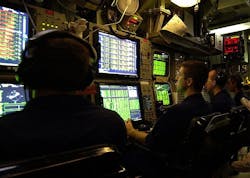General Dynamics to continue upgrading hardware and software for Navy submarine combat systems
Officials of the Naval Sea Systems Command in Washington are asking General dynamics to upgrade the AN/BYG-1 submarine weapons control system (WCS), involving several hardware and software upgrades called technology insertions (TI) and advanced processing builds (APB).
These upgrades are for the combat systems and computers aboard several different kinds of U.S. submarines, including ballistic-missile submarines, cruise-missile submarines, and fast-attack submarines.
The contract involves the AN/BYG-1 open-architecture submarine combat control system that enables ballistic-missile and fast-attack submarines to analyze and track other submarine and surface ship contacts for situational awareness, as well as for aiming and firing torpedoes and missiles.
The contract modification calls for General Dynamics to finish upgrades to the AN/BYG-1 weapons control system hardware and software begun over the past several years to keep the AN/BYG-1 submarine combat system up to date and technologically relevant.
Related: ASSETT to apply artificial intelligence and machine autonomy to submarine combat systems
General Dynamics is involved in a continuing process of upgrading the AN/BYG-1 submarine combat system with commercial off-the-shelf (COTS) computers. The company is replacing central processors with COTS computers, and is refreshing submarine combat system processors with new COTS technologies each year or two.
The AN/BYG-1 system is a counterpart to the Navy's Advanced Rapid COTS Insertion (A-RCI) program that uses COTS computers in submarine sonar signal processing systems.
Submarine crews equipped with the AN/BYG-1 combat control system are able to analyze submarine sensor contact information to track submarine and surface vessels in open-ocean and coastal waters; aim and fire heavyweight torpedoes against enemy submarines and surface ships; receive strike warfare orders, plan strike missions and employ Tomahawk land-attack cruise missiles; and receive and synthesize sensor data and external tactical intelligence to produce an integrated tactical picture for situational awareness.
The AN/BYG-1 program includes a combat control system for Virginia-class attack submarines, as well as upgraded combat control systems for Los Angeles- and Seawolf-class attack submarines, as well as for Ohio-class ballistic-missile and cruise-missile submarines. General Dynamics also is providing AN/BYG-1 system upgrades for Australian Collins-class attack submarines.
Related: Navy asks Progeny Systems to develop submarine combat system software that controls weapons
The program uses biennial software upgrades called advanced processor builds and hardware upgrades called technology insertions. The AN/BYG-1 modernization program separates development of the tactical control system (TCS) and the weapons control system (WCS) to enable independent yet parallel development and certification of these computer systems, General Dynamics officials say. Each of these systems uses a variety of APB software algorithms developed by industry, government, and academia.
The computer hardware portion of BYG-1 integrates sensor inputs to provide a secure common operational picture and improved situational awareness that blends information from sonar, electronic support measures, radar, navigation, periscopes, and communications systems. This system architecture allows for rapid COTS insertion to accommodate and integrate additional functionality and sensors.
One of the benefits of rapid COTS technology upgrades to submarine combat systems is the ability for the Navy to learn from real-world experience to make quick improvements. Recent Navy recommendations, for example, were to acquire automation technology to help the operator in areas of high contact density.
On this order General Dynamics will do the work in Pittsfield, Mass., and should be finished by June 2019. For more information contact General Dynamics Mission Systems online at https://gdmissionsystems.com, or Naval Sea Systems Command at www.navsea.navy.mil.
Learn more: search the Aerospace & Defense Buyer's Guide for companies, new products, press releases, and videos
